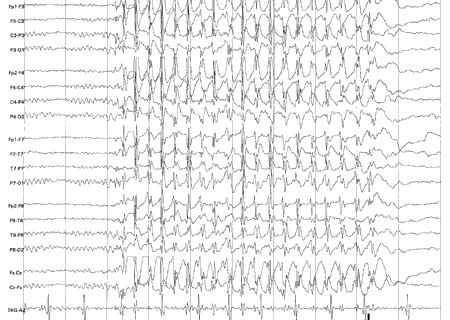Approach
The critical components to the diagnosis of an absence epilepsy syndrome are a detailed description of the patient's unusual episodes and the EEG characteristics.
History
Essential to the history is a detailed description of the unusual episode, including:
Patient's activity at onset: behavioural arrest or staring; interrupting otherwise normal activity
Simple or complex automatisms: any associated movements of eyes, face, and hands[32]
The duration of an event: typically lasting 5 to 10 seconds
The frequency of events: several per day
No aura and minimal to no postictal state should occur
Age of onset
Birth and developmental history, including specifically any history of learning disabilities or problems such as attention deficit hyperactivity disorder (ADHD), as well as any prior history of seizures of any type, which is also significant in considering the specific classification of the electroclinical syndrome.
Physical Examination
For childhood absence epilepsy (CAE), juvenile absence epilepsy (JAE), and juvenile myoclonic epilepsy (JME), a patient should typically have an entirely normal physical examination. However, hyperventilation is an easily performed manoeuvre that often will trigger absence seizures and can be diagnostic on clinical grounds.
If the patient has evidence of cognitive impairment or abnormalities in muscle tone or tendon reflexes, an epilepsy syndrome that is more likely to be symptomatic (due to an identified structural brain lesion), such as Lennox-Gastaut, is probable. Abnormal physical or cognitive findings indicate the need for further diagnostic work-up, such as MRI or metabolic and genetic testing.
EEG
An EEG should be ordered in the initial assessment of all patients. The EEG should be conducted when the patient is sleep deprived, to include those periods of time when the patient is alternately awake and asleep. It is essential to ask the patient to hyperventilate in order to induce an absence seizure, a classic finding.
The EEG may be repeated to assess treatment response in CAE. There is some suggestion that normalisation of EEG correlates with greater likelihood of resolution of CAE.
For typical absence seizures, a classic 3 Hz generalised spike-and-wave pattern, often activated by hyperventilation, is considered the most specific and sensitive test confirming a diagnosis of absence seizures. [Figure caption and citation for the preceding image starts]: 3 Hz generalised spike-and-wave pattern on EEG pathognomonic for typical absence seizures and childhood absence epilepsyFrom the personal collection of Dr M. Wong; used with permission [Citation ends]. For atypical absence seizures a slow (<2.5 Hz) generalised spike-wave pattern is characteristic. [Figure caption and citation for the preceding image starts]: Slow (<2.5 Hz) generalised spike-and-wave on EEG associated with atypical absence seizures and Lennox-Gastaut syndromeFrom the personal collection of Dr M. Wong; used with permission [Citation ends].
For atypical absence seizures a slow (<2.5 Hz) generalised spike-wave pattern is characteristic. [Figure caption and citation for the preceding image starts]: Slow (<2.5 Hz) generalised spike-and-wave on EEG associated with atypical absence seizures and Lennox-Gastaut syndromeFrom the personal collection of Dr M. Wong; used with permission [Citation ends].
MRI
An MRI is required only in settings where the history, clinical course, physical examination, or EEG findings do not fit with typical absence seizures or generalised epilepsy syndromes.
Metabolic testing
Metabolic tests are generally indicated when the clinical and EEG findings do not fit with typical absence seizures or typical epilepsy syndrome but suggest a symptomatic aetiology. There is a broad variety of metabolic tests that can be performed and these need to be tailored to the individual. Possible metabolic disorders causing atypical absence seizures include aminoacidurias, organic acidurias, mitochondrial disorders, and lysosomal storage diseases. Testing of cerebrospinal fluid and serum glucose should be considered for patients under age 4 years or with intractable absence epilepsy to evaluate for glucose transporter 1 (GLUT1) deficiency.[29][33]
Genetic testing
In rare instances with a characteristic family history of other generalised epilepsies (generalised epilepsy with febrile seizures plus [GEFS+]), commercial testing for SCN1A gene mutations may be indicated. As more genes are identified for these syndromes, this may become more common. For epilepsies involving atypical absence seizures, karyotype and more detailed chromosomal analysis may be indicated.
For patients under age 4 years or with intractable absence epilepsy, genetic testing of the SLC2A1 gene for GLUT1 deficiency should be considered.[29][33][34][35]
Use of this content is subject to our disclaimer